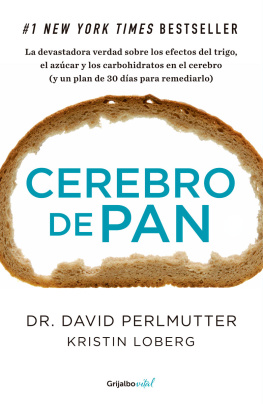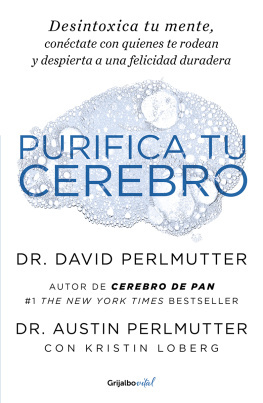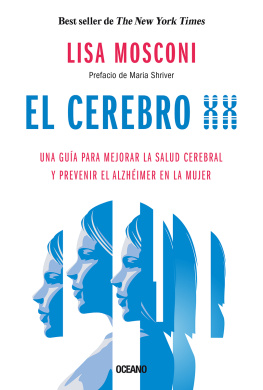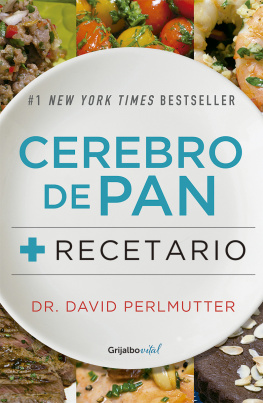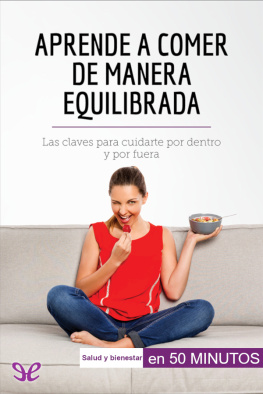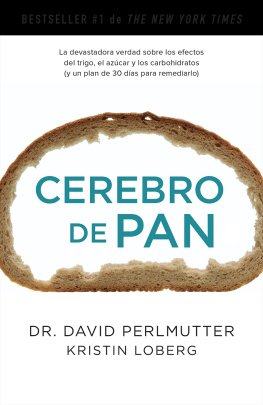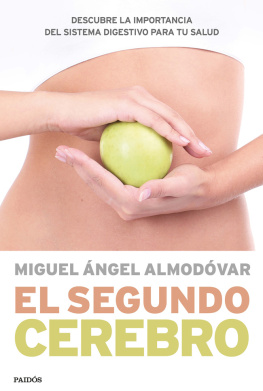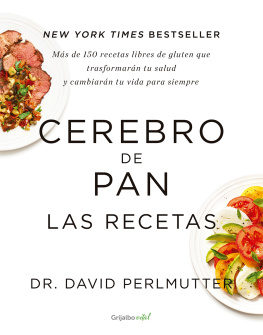NOTAS
La siguiente es una compilación de artículos, libros, textos y recursos electrónicos de corte científico que te podrán ser útiles para aprender más sobre algunas de las ideas y los conceptos expresados en este libro. No pretende ser una lista exhaustiva, pero es un punto de partida para adquirir una nueva visión y empezar a vivir según los principios de Alimenta tucerebro. Muchas de las citas se relacionan con estudios mencionados de paso o descritos a detalle en el texto. Estos materiales también podrían abrir puertas a futuras investigaciones e inquisiciones.
Introducción: Alerta microbiana
C. Pritchard, A. Mayers y D. Baldwin, “Changing Patterns of Neurological Mortality in the 10 Major Developed Countries — 1979-2010”, Publ. Health 127, núm 4 (abril de 2013): 357-368. Véase también Bournemouth University, “Brain Diseases Affecting More People and Starting Earlier Than Ever Before,” ScienceDaily, 10 de mayo de 2013; fecha de acceso: 8 de enero de 2015, http://www.sciencedaily.com/releases/2013/05/130510075502.htm.
Michael D. Hurd et al., “Monetary Costs of Dementia in the United States”, N. Engl. J. Med. 368 (4 de abril de 2013): 1326-1334.
“Statistics”, NIMH RSS; fecha de acceso: 12 de enero de 2015, http://www.nimh.nih.gov/health/statistics/index.shtml.
Idem.
“Depression”, WHO, octubre de 2012; fecha de acceso: 12 de enero de 2015, http://www.who.int/mediacentre/factsheets/fs369/en/.
Kate Torgovnick, “Why Do the Mentally Ill Die Younger?”, Time, 3 de diciembre de 2008; fecha de acceso: 15 de enero de 2015, http://content.time.com/time/health/article/0,8599,1863220,00.html.
“Headache Disorders”, WHO, octubre de 2012; fecha de acceso: 15 de enero de 2015, http://www.who.int/mediacentre/factsheets/fs277/en/.
“Do You Practice Headache Hygiene?”, HOPE Health Letter, julio de 2014, https://www.hopehealth.com/reports/PDF/ HeadacheHygiene.pdf.
“Frequently Asked Questions about Multiple Sclerosis”, Multiple Sclerosis FAQs and MS Glossary; fecha de acceso: 12 de enero de 2015, http://www.mymsaa.org/about-ms/faq/.
“Multiple Sclerosis Statistics”, Statistic Brain RSS; fecha de acceso: 12 de enero de 2015, http://www.statisticbrain.com/multiplesclerosis-statistics/.
“Data & Statistics” Centers for Disease Control and Prevention, 24 de marzo de 2014; fecha de acceso: 12 de enero de 2015, http://www.cdc.gov/ncbddd/autism/data.html.
“NIH Human Microbiome Project Defines Normal Bacterial Makeup of the Body”, U.S National Library of Medicine; fecha de acceso: 12 de enero de 2015, http://www.nih.gov/news/health/jun2012/nhgri-13.htm.
“Human Microbiome Project DACC — Home”, Human Microbiome RSS; fecha de acceso: 12 de enero de 2015, http://hmp dacc.org/.
S. Reardon, “Gut-Brain Link Grabs Neuroscientists”, Nature 515 (13 de noviembre de 2014): 175-177, doi: 10.1038/515175a.
Se le suele atribuir esta cita a Hipócrates, pero, de hecho, no es posible encontrar esta frase en ninguno de sus escritos. Aunque el vínculo entre elecciones alimenticias y salud ha sido reconocido y documentado por la ciencia durante siglos, hasta Hipócrates estaría de acuerdo en que el concepto de alimentación no debe confundirse con el de medicación. En 2013 Diana Cárdenas, de la Universidad Descartes de París, escribió un artículo sobre esta creación literaria, en el que muestra que al menos una revista biomédica en los últimos 30 años ha citado esta frase erróneamente adjudicada. No obstante, sigue siendo un buen adagio, el cual es relevante y cierto sin importar quién lo haya acuñado.
Capítulo 1: Bienvenido a bordo
Dan Buettner, “The Island Where People Forget to Die”, New York Times Magazine, 24 de octubre de 2012, http://www.nytimes.com/2012/10/28/magazine/the-island-where-people-forget-to-die.html.
D. B. Panagiotakos et al., “Sociodemographic and Lifestyle Statistics of Oldest Old People (>80 Years) Living in Ikaria Island: The Ikaria Study”, Cardiol. Res. Pract. 2011 (24 de febrero de 2011): ID 679187, 7 pp.
“Link between Microbes and Obesity”, MicrobeWiki, Kenyon College; fecha de acceso: 12 de enero de 2015, https://microbewiki.kenyon.edu/index.php/Link_Between_Microbes_and_Obesity.
“NIH Human Microbiome Project Defines Normal Bacterial Makeup of the Body”, U.S National Library of Medicine; fecha de acceso: 12 de enero de 2015, http://www.nih.gov/news/health/jun 2012/nhgri-13.htm.
“How Bacteria in the Gut Help Fight Off Viruses”, NPR; fecha de acceso: 12 de enero de 2015, http://www.npr.org/blogs/goatsandsoda/2014/11/14/363375355/how-bacteria-in-the-gut-help-fight-off-viruses.
Adam Hadhazy, “Think Twice: How the Gut’s ‘Second Brain’ Influences Mood and Well-Being”, Scientific American, 12 de febrero de 2010, http://www.scientificamerican.com/article/ gut-second-brain/.
Doctor Siri Carpenter, “That Gut Feeling”, Am. Psychol. Assoc. 43, núm. 8 (septiembre de 2012): 50, http://www.apa.org/monitor/ 2012/09/ gutfeeling.aspx.
Idem.
Ivana Semova et al., “Microbiota Regulate Intestinal Absorption and Metabolism of Fatty Acids in the Zebrafish”, Cell Host & Microbe 12, núm. 3 (2012): 277. Véase también University of North Carolina School of Medicine, “Gut Microbes Help the Body Extract More Calories from Food”, ScienceDaily, 12 de septiembre de 2012; fecha de acceso: 8 de enero de 2015, http://www.sciencedaily.com/releases/2012/09/120912125114.htm.
N. Abdallah Ismail, “Frequency of Firmicutes and Bacteroidetes in Gut Microbiota in Obese and Normal Weight Egyptian Children and Adults”, Arch. Med. Sci. 7, núm. 3 (junio de 2011): 501-507, doi: 10.5114/aoms.2011.23418, Epub 11 de julio de 2011.
H. Kumar et al., “Gut Microbiota as an Epigenetic Regulator: Pilot Study Based on Whole-Genome Methylation Analysis”, mBio 5, núm. 6 (2014): e02113-14, doi: 10.1128/mBio.02113-14.
“Clostridium difficile Infection”, Centers for Disease Control and Prevention, 1 de marzo de 2013; fecha de acceso: 12 de enero de 2015, http://www.cdc.gov/HAI/organisms/cdiff/Cdiff_infect.html.
“For Medical Professionals: Quick, Inexpensive and a 90 Percent Cure Rate”; fecha de acceso: 12 de enero de 2015, http://www.mayoclinic.org/medical-professionals/clinical-updates/digestive-diseases/quick-inexpensive-90-percent-cure-rate.
Tanya Lewis, “Go with Your Gut: How Bacteria May Affect Mental Health”, LiveScience, 8 de octubre de 2013; fecha de acceso: 12 de enero de 2015, http://www.livescience.com/40255-how-bacteria-affect-mental-health.html.
K. Aagaard et al., “The Placenta Harbors a Unique Microbiome”, Sci. Transl. Med. 237, núm. 6 (21 de mayo de 2014): 237ra65.
Kerry Grens, “The Maternal Microbiome”, The Scientist, 21 de mayo de 2014, http://www.the-scientist.com/?articles.view/articleNo/40038/title/The-Maternal-Microbiome/.
M. G. Dominguez-Bello et al., “Delivery Mode Shapes the Acquisition and Structure of the Initial Microbiota across Multiple Body Habitats in Newborns”, Proc. Natl. Acad. Sci. USA 107, núm. 26 (29 de junio de 2010): 11971-11975, Epub 21 de junio de 2010.
M. B. Azad et al., “Gut Microbiota of Healthy Canadian Infants: Profiles by Mode of Delivery and Infant Diet at 4 Months”, CMAJ 185, núm. 5 (19 de marzo de 2013): 385-394, Epub 11 de febrero de 2013.
Canadian Medical Association Journal, “Infant Gut Microbiota Influenced by Cesarean Section and Breastfeeding Practices; May Impact LongTerm Health”, ScienceDaily, 11 de febrero de 2013; fecha de acceso: 8 de enero de 2015, http://www.sciencedaily.com/ releases/2013/02/130211134842.htm.
Martin J. Blasser, Missing Microbes (Nueva York: Henry Holt, 2014).

